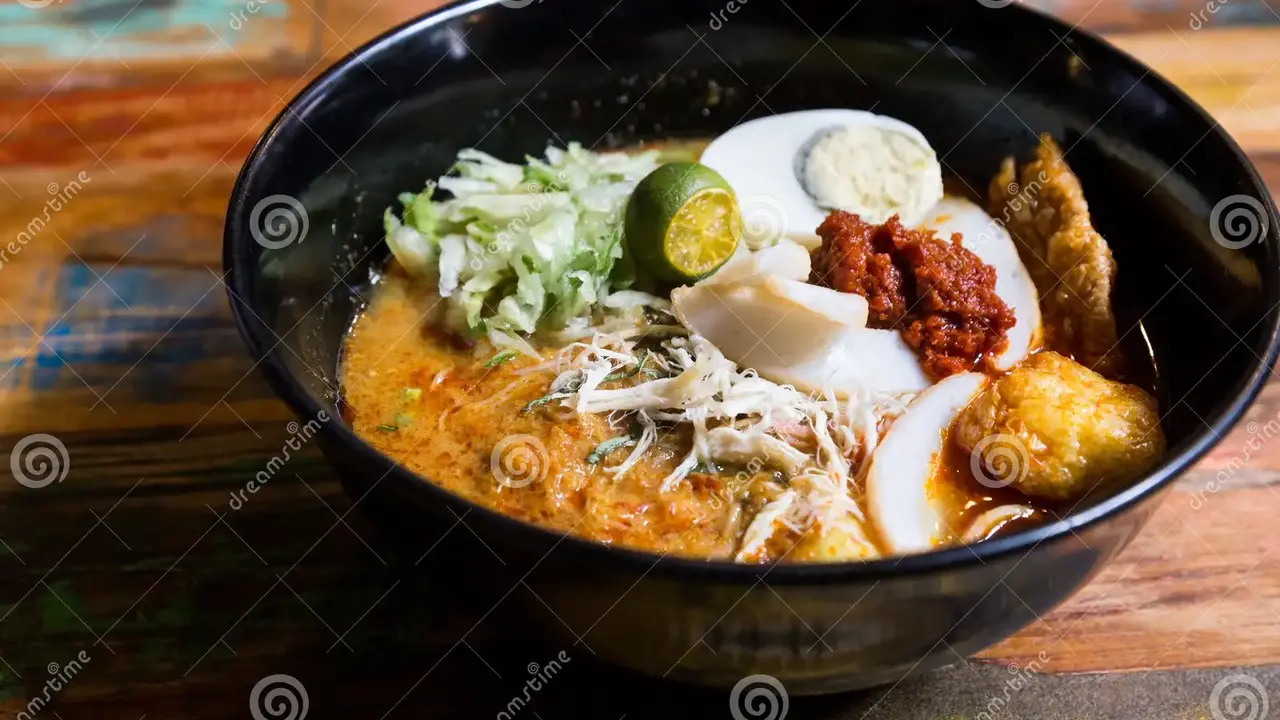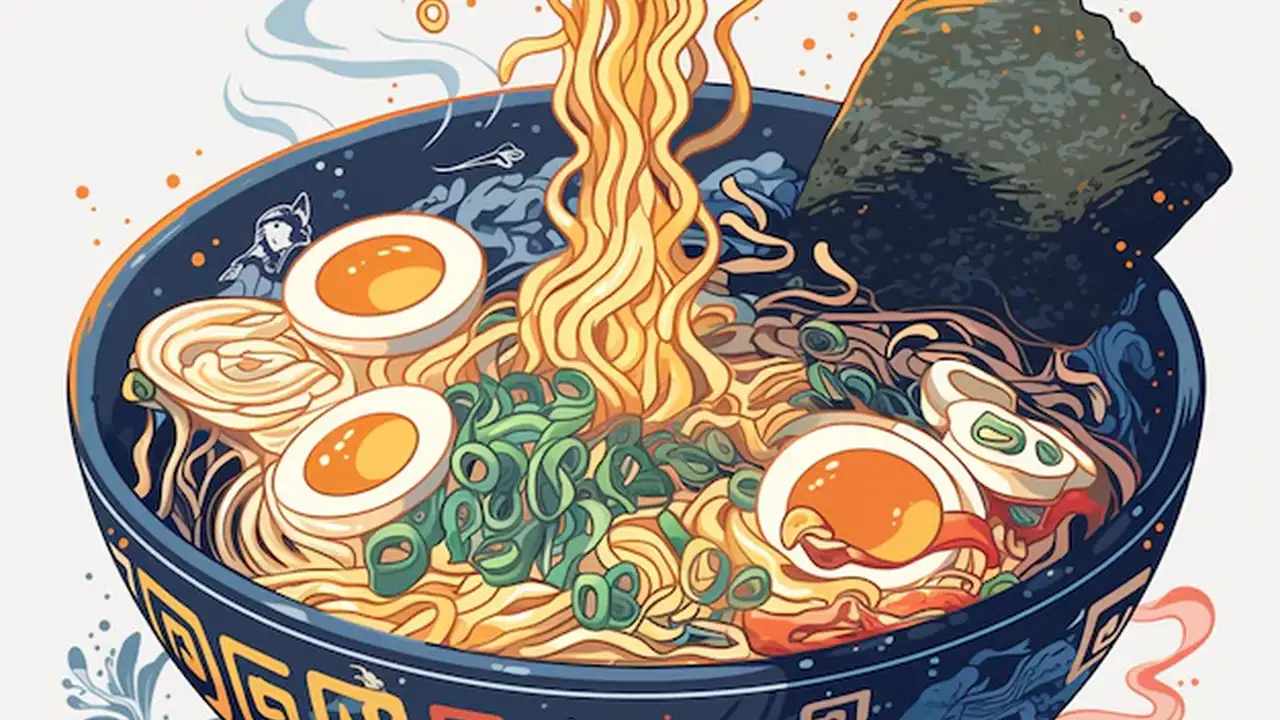Laksa: A Spicy Noodle Soup in Malaysia

What is Laksa A Deep Dive into Malaysian Culinary Heritage
Alright, let's talk laksa! If you're visiting Malaysia, or even just dreaming about it, you absolutely *have* to try this iconic dish. It’s more than just a soup; it's a cultural experience, a flavor explosion, and a conversation starter all rolled into one steaming bowl. But what exactly *is* laksa? Well, hold on tight, because we’re about to dive deep.
Laksa is essentially a spicy noodle soup, but that's like saying the Mona Lisa is just a painting. The magic lies in the broth. It's a complex concoction, usually coconut milk-based (but not always!), infused with a vibrant blend of spices. Think chili, lemongrass, galangal, turmeric, and a whole host of other fragrant ingredients. This creates a rich, creamy, and utterly addictive broth that will have you slurping until the very last drop.
Then there are the noodles! Thick rice noodles are the most common, providing a satisfying chewiness that complements the smooth broth perfectly. And the toppings? Oh, the toppings! This is where laksa gets really interesting. You'll find everything from prawns and cockles to tofu puffs, fish cakes, and bean sprouts, each adding its own unique texture and flavor to the mix.
But here's the thing: laksa isn't just one dish. It's a family of dishes, each with its own regional variations and unique characteristics. Think of it like pizza; you have your classic Margherita, but then you also have Hawaiian, pepperoni, and a million other variations. Laksa is the same, with each region in Malaysia (and even neighboring countries like Singapore and Indonesia) putting its own spin on this beloved soup.
Laksa Variations Exploring the Regional Differences and Ingredients
So, what are some of the different types of laksa you might encounter? Let's take a quick tour:
Asam Laksa Penang's Tangy Delight
First up, we have Asam Laksa, hailing from the island of Penang. This is probably the most well-known type of laksa, and it's famous for its tangy and slightly sour broth. The "asam" refers to tamarind, which gives the soup its distinctive sourness. Unlike many other laksas, Asam Laksa doesn't use coconut milk. Instead, it relies on a fish-based broth, often made with mackerel, and is flavored with shrimp paste (also known as "hae ko"). The result is a lighter, more refreshing laksa that's perfect for a hot day. You'll also find shredded fish, cucumber, pineapple, mint, and a dollop of shrimp paste on top.
Curry Laksa The Creamy Comfort Food of Malaysia
Next, we have Curry Laksa, also known as Curry Mee in some regions. This is the creamy, coconut milk-based laksa that many people think of when they hear the word "laksa." The broth is rich and decadent, thanks to the generous addition of coconut milk and a blend of aromatic spices. Curry Laksa typically includes tofu puffs, prawns, cockles, fish cakes, and long beans. It's a hearty and satisfying meal that will warm you from the inside out. You often get to choose your noodles - yellow noodles (mee), rice vermicelli (bee hoon), or a combination of both.
Sarawak Laksa A Spice Symphony from Borneo
Then there's Sarawak Laksa, a specialty of the Malaysian state of Sarawak on the island of Borneo. This laksa is known for its complex and aromatic broth, which is made with a blend of over 20 different spices. The key ingredient is a special laksa paste that's unique to Sarawak. The broth is also enriched with coconut milk and prawns. Sarawak Laksa is typically served with prawns, shredded chicken, bean sprouts, and a garnish of coriander. It's a truly unique and unforgettable laksa experience. The late Anthony Bourdain famously declared Sarawak Laksa as "Breakfast of the Gods."
Laksam Kelantan's Rolled Rice Noodle Delight
Finally, let's not forget Laksam, a specialty of the state of Kelantan. This laksa is unique for its use of thick, rolled rice noodles. The noodles are soft and slightly chewy, and they soak up the rich, coconut milk-based gravy beautifully. The gravy is typically made with fish and coconut milk, and it's flavored with a blend of spices. Laksam is often served with shredded cucumber, bean sprouts, and a dollop of chili paste.
Where to Find the Best Laksa in Malaysia A Culinary Adventure
Okay, so you're convinced you need to try laksa. But where do you find the *best* laksa in Malaysia? Here are a few suggestions:
- Penang: For the best Asam Laksa, head to Georgetown, Penang. Look for street food stalls and hawker centers. Kim Laksa and Air Itam Laksa are legendary.
- Kuala Lumpur: For Curry Laksa, try Old Town White Coffee (a chain, but reliable) or look for smaller, independent restaurants specializing in Curry Mee.
- Sarawak: To experience authentic Sarawak Laksa, you'll need to visit Kuching, the capital of Sarawak. Numerous coffee shops and restaurants serve it. Ask locals for their favorite spot!
- Kelantan: For Laksam, head to Kota Bharu, the capital of Kelantan. Look for stalls selling it in the morning markets.
Laksa at Home Recipes and Ingredients for Your Kitchen
Want to try making laksa at home? It might seem intimidating, but it's definitely doable! Here's a basic overview of the ingredients you'll need:
- Noodles: Choose thick rice noodles, yellow noodles, or rice vermicelli, depending on the type of laksa you're making.
- Laksa Paste: This is the key to the flavor! You can buy pre-made laksa paste at Asian supermarkets, or you can make your own from scratch (which is more time-consuming but incredibly rewarding).
- Coconut Milk: Full-fat coconut milk is essential for creamy laksas.
- Protein: Prawns, cockles, fish cakes, tofu puffs, chicken – the choice is yours!
- Vegetables: Bean sprouts, long beans, cucumber, pineapple, mint – add whatever you like!
- Garnish: Coriander, chili paste, lime wedges – for that final touch of flavor.
Laksa Product Recommendations and Comparisons Price Points and Usage Scenarios
Alright, let's get down to some specific product recommendations. These are based on my own experiences and what's readily available in most international markets (especially online).
Laksa Paste Recommendations Building Your Broth Foundation
- A1 Laksa Paste (Around $5-$7 per packet): This is a widely available and affordable option. It's a good starting point for beginners. The flavor is decent, though it might need a little extra tweaking with additional spices. *Usage Scenario:* Perfect for a quick and easy weeknight laksa.
- Prima Taste Laksa La Mian (Around $10-$12 per packet): This is a more premium option that comes with pre-cooked noodles and a richer, more complex laksa paste. It's a great choice if you want a restaurant-quality laksa at home without too much effort. *Usage Scenario:* Ideal for impressing guests or treating yourself to a special meal.
- Tean's Gourmet Paste for Asam Laksa (Around $6-$8 per packet): If you're specifically looking to make Asam Laksa, this is a great option. It captures the tangy and savory flavors of Penang Asam Laksa very well. *Usage Scenario:* Perfect for recreating the authentic taste of Penang Asam Laksa at home.
Coconut Milk Choices From Cans to Cartons
- Canned Coconut Milk (Various Brands, Around $2-$4 per can): This is the most common and readily available option. Choose full-fat coconut milk for the richest flavor. *Usage Scenario:* Suitable for all types of laksa.
- Cartoned Coconut Milk (Various Brands, Around $3-$5 per carton): Cartoned coconut milk is often slightly less thick than canned, but it's a good option if you prefer the convenience. *Usage Scenario:* Good for lighter laksas or if you want a slightly less rich flavor.
- Fresh Coconut Milk (Varies Greatly in Price and Availability): If you can find fresh coconut milk, it will definitely elevate your laksa to the next level. The flavor is much more vibrant and authentic. *Usage Scenario:* Best for special occasions or when you really want to impress.
Noodle Options From Rice to Wheat
- Dried Rice Noodles (Various Brands, Around $3-$5 per package): These are a versatile and affordable option. Soak them in hot water before adding them to the laksa. *Usage Scenario:* Suitable for all types of laksa.
- Fresh Yellow Noodles (Varies Greatly in Price and Availability): Fresh yellow noodles have a slightly chewy texture and a distinct flavor that complements Curry Laksa very well. *Usage Scenario:* Best for Curry Laksa.
- Rice Vermicelli (Various Brands, Around $2-$4 per package): These thin rice noodles are a good option for Asam Laksa. *Usage Scenario:* Best for Asam Laksa.
Laksa Hacks and Tips Elevating Your Noodle Game
Here are a few tips and tricks to take your laksa game to the next level:
- Toast your spices: Before adding your laksa paste to the broth, toast the spices in a dry pan for a few minutes to release their aroma.
- Use good quality fish sauce: A splash of good quality fish sauce can add depth and umami to the broth.
- Don't be afraid to experiment: Laksa is a very forgiving dish, so don't be afraid to experiment with different ingredients and flavors.
- Garnish generously: A generous garnish of fresh herbs, chili paste, and lime wedges can really elevate the dish.
- Make it your own: Add your favorite vegetables, proteins, and toppings to create a laksa that's perfect for you.
Laksa A Culinary Journey Worth Taking
So, there you have it! A deep dive into the wonderful world of laksa. From its humble beginnings as a street food staple to its current status as a beloved national dish, laksa has captured the hearts (and stomachs) of people all over the world. So, whether you're a seasoned laksa aficionado or a curious newbie, I encourage you to embark on your own laksa adventure. Explore the different variations, try new ingredients, and most importantly, have fun! You might just discover your new favorite food.
:max_bytes(150000):strip_icc()/277019-baked-pork-chops-with-cream-of-mushroom-soup-DDMFS-beauty-4x3-BG-7505-5762b731cf30447d9cbbbbbf387beafa.jpg)






